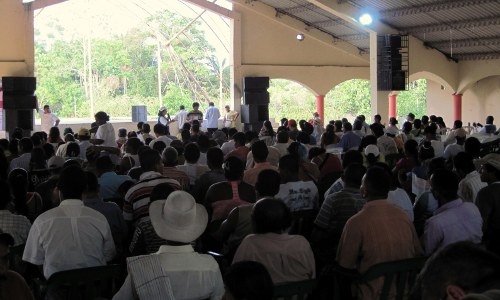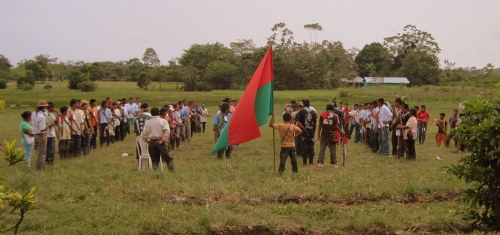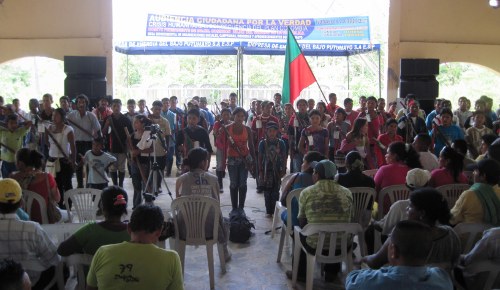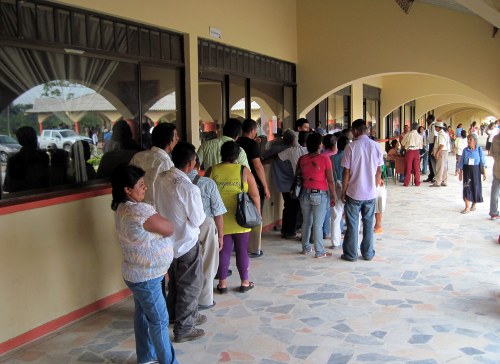The message was clear. Putumayo's social organisations seek justice, a legal and social justice that is fundamental in the construction of a path towards a true and just peace.
Citizens' Assembly for Truth
In the heart of Putumayo, one of the most troubled regions in Colombia, a coalition of grass-roots and human rights organisations held a two day event offering an opportunity for reflection, analysis and the highlighting of the reality being lived in the region. The 'Citizens' Assembly for Truth' offered an integral space to the region's many victims of the conflict. Human rights lawyers offered their assistance taking record of the hundreds of cases as the victims of Putumayo seek an end to the humanitarian crisis and an end to the impunity that continues to reign throughout Colombia.

Putumayo: Conflict zone
Putumayo has lived and continues to live the most extreme of the country's armed conflict. One of Colombia's 32 departamentos, Putumayo lies in the South-west with its limits forming an international border with Ecuador and Peru. This geographical location in the South-west border region, alongside the presence and heavy exploitation of oil and the cultivation of the coca crop since the 1980's, has undoubtedly contributed to its fate. There has been heavy guerrilla presence for several decades.
FARC-EP the country's largest left wing guerrilla group has maintained a strong influence in the region with its Frente 32 and Frente 48. Towards the end of last year and in the first few months of the current year, the guerrilla has mounted a series of attacks against Colombian police and armed forces. One attack left 8 policemen dead in one of the most serious losses suffered by the security forces in recent times.
There is heavy militarisation from state armed forces as the military seeks to combat the guerrilla and maintain control in areas where oil exploitation is being carried out. Plan Colombia, a US aid package which has supplied Colombia with over 6 billion dollars in predominantly military aid has hit the region hard as indiscriminate aerial fumigation and forced manual eradication, a fundamental part of the bilateral agreement, has caused widespread damage and led to the continued forced displacement of Putumayo's citizens.
“It is presented as a success [Plan Colombia],” remarked Mario, a campesino leader forming part of the coalition of regional grass-roots organisations (La Mesa departamental de organizaciones sociales, campesinas, indigenas, afrodescendientes del Putumayo) who, alongside the human rights organisation Comité permanente por la defensa de los Derechos Humanos (CPDH), played a key role in the organisation of the event. “They talk of security gains and a reduction in poverty levels. But for the campesinos it has brought misery, forced displacement and death.” And there is the continued paramilitary presence. A presence that continues even after their almost ten year reign of horror was supposedly ended with the government supported demobilisation of the paramilitary unit operating in the region, the Frente Sur Putumayo, in March 2006.

Paramilitary destruction
Although paramilitary violence was already present in Putumayo during the 80's and early 90's, it was in 1997 with the arrival of the unified paramilitary forces Autodefensas Unidas de Colombia (AUC) that their true damage was inflicted on Putumayo's population. The AUC was a paramilitary army guilty of carrying out often unimaginable crimes across Colombia during the 1990's and 2000's until their demobilisation in the middle of the last decade. Maintaining a strategy of using brutal violence and massacres to instil fear into the population, they caused massive displacement taking control of huge swaths of territory for their drug trafficking or the business interests of their associates. They enjoyed widespread support from the state with military officials, police commanders, intelligence chiefs, politicians, members of the justice system, and relatives of the President guilty of deeply entrenched collaboration. Although they officially demobilised under a government run initiative, they continue to act and enjoy vast influence in various parts of the country – Putumayo inevitably included. A recently released UN human rights report (pdf) highlights these paramilitary successor groups and their widespread collusion with state forces.
In Putumayo the Frente Sur Putumayo is held responsible for crimes leaving 5,500 victims. Entering into the region under the premise of defeating the guerrilla, they brutally massacred the civilian population to take control of territory and the drugs trade. Colombia's public prosecutor's office, La Fiscalía, estimates that 3,000 murdered victims are buried in mass graves. Several now infamous massacres were carried out. Victims were dismembered, often whilst still alive. And several ex-paramilitary soldiers report the collaboration and support from state forces. Although this paramilitary group has officially demobilised and the much criticised Justice and Peace law – a law introduced in 2005 giving a degree of amnesty to ex-paramilitary fighters in exchange for testimonies – has allowed certain truths to become public, the victims are still a long way from obtaining justice.
One young victim, Pablo Oswaldo, present at the 'Citizens' Assembly for Truth' told his story. On the 15 February 2003 travelling along the river in the Puerto Guzman municipality his boat was attacked by three paramilitaries. Without a word the paramilitaries opened fire. Seven civilians were travelling on the boat. Six were killed, including Pablo's father. Pablo was 14 years old at the time, finishing his secondary education. The young student and only survivor of the massacre lost his right arm. He studied no more as he was forced to live a new life. He has received no assistance from the state. He has heard nothing regarding the investigation into the crime. Impunity reigns.

Continued paramilitary violence
Under new names, the paramilitary forces continue to enjoy a heavy presence and a significant social control in the region. Las Águilas Negras (the Black Eagles) and Los Rastrojos (the Stubble) continue to threaten, instil fear and commit atrocities. On the very day the event was taking place there was a stark reminder of this reality. A member of the Mesa departamental de organizaciones sociales, campesinas, indigenas, afrodescendientes del Putumayo denounced to the audience that on 11 February five civilians were massacred including a 5 year old girl who had her hands cut off and her throat slit. The coalition of grass-roots and human-rights organisations demanded that state authorities investigate the paramilitary presence in the region. There were also demands that the Colombian Army comply with its obligation to protect the civilian population – particularly as members of the armed forces were positioned in the surrounding area to where the massacre took place. One of those killed in the massacre was a community leader. Indeed, with the continued existence of these paramilitary successor groups, community leaders, social activists, human rights defenders, even victims denouncing the crimes committed against them, live in an environment of permanent risk. With no justice and continued impunity the perpetrators of these crimes will continue to sow terror across Putumayo as they know there will be no recrimination. The organisations defending the interests of the communities and their victims will continue to be threatened. And, as such, the victims will continue to be 're-victimised' pushing even further into the distance the possibility of achieving justice.
The victims of Putumayo
With the objective to highlight this reality, strengthen the unity of Putumayo's civil society, and demand an end to impunity, over 800 members of the Putumayo community attended the two day public event. Delegates from the almost 30 regional organisations forming part of the grass-roots coalition travelled from across the departamento. A series of human rights organisations, including CPDH, provided a total of 20 professionals who provided legal and psychological support to the victims. A total of 390 cases were recorded with 37 of these cases of often incomprehensible tragedy presented from the stage by their courageous victims. Extra-judicial executions carried out by the army, forced disappearances, arbitrary detentions, torture by state forces, forced displacement, death threats, bombardments and the arbitrary fumigation of crops were all reported.
A delegate from a teacher's association, Asosiación de Educadores del Putumayo, reported how 20 teachers had been killed since 1997. In not a single case has a charge been made.
We heard how one two-year-old girl lost her leg after three army helicopters attacked her nursery. After the attack she was refused entry at the local hospital for not having the correct papers, was later sent to the capital but it was too late to save her from having her limb amputated.

Numerous campesinos denounced the impact of the aerial fumigations carried out by the Colombian military as part of Plan Colombia. A campesina told us how in November 1999, 20 days after bathing in a stream that had been recently fumigated with the Glyphosate chemical used by the Colombian military in the fumigations, her husband fell ill – four days later he died. Others reported the destruction of their crops: corn, beans, plantain, rice, cassava, all arbitrarily fumigated as part of the government's US backed anti-narcotics program. They have received no compensation.
A trade-unionist and leader of sugar-cane workers informed the audience of his ordeal. An emblematic case demonstrating the 'victimisation' and 're-victimisation' suffered by so many community activists and human rights defenders. In August 2002 he had 7 Ha (1 Hectare is equal to 2.5 acres) of sugar-cane destroyed by aerial fumigations. He carried on. In July 2003 he had 22 Ha of sugar-cane cultivated and ready for harvest. At the beginning of that month came the second fumigation destroying once more his entire crop. As he sought justice for his damaged crops he received nothing less than attacks from paramilitaries, accusations of growing sugar-cane for the guerrilla from the the state's criminal investigation unit (CTI), and a series of arrest warrants which led to his detention for rebellion. He was released after eight days.
An end to impunity
Colombia's high impunity rate is alarming. According to the Washington based human rights organisation US Office on Colombia, of 784 human rights defenders threatened, attacked, or assassinated (pdf) between 2002 and 2009, only ten cases have seen a conviction. Indeed UN officials have repeatedly manifested their concern, again questioning government achievements in their recently released annual human rights report. But it is not just the impunity that is of concern. Instead of receiving positive judicial results, the victims are often confronted with further threats, attacks or even legal processes.
Before the close of the event, the 390 cases were collected together and, with the backing of a senator and two house representatives, were presented to a delegate from the public prosecutor's office. The coalition of grass-roots and human rights organisations have acted and will continue to act in the search of an end to impunity and a new social reality for Putumayo. The responsibility lies also with the public institutions to comply with their obligations, to push for an end to impunity, and to provide justice for the victims of Putumayo and the many more across Colombia.
As Mario the campesino leader succinctly affirmed, “for true peace, first there must be justice.”
(The names in the article have been changed)












